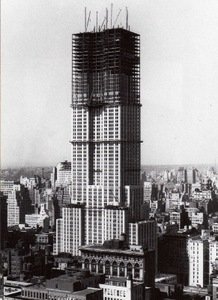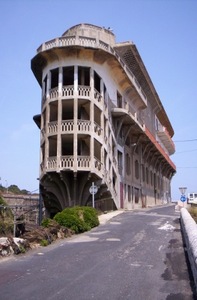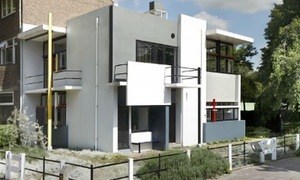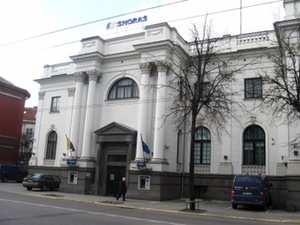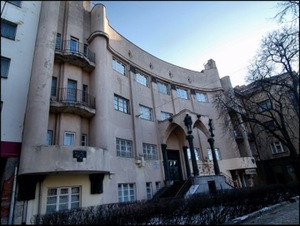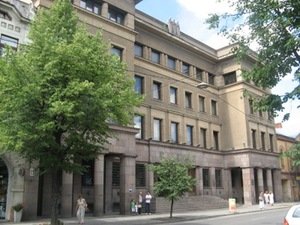Expressive interwar architecture 6
In brief: Cruel events of the World War I left a marked trace in the history of the world. Cities of the Netherlands and Belgium turned into ruins, many European cities lost their old heritage and were forced to create their urban portrait anew. New trends of architecture appeared in the world in about 1918. Therefore, the article is dedicated to the change of the face of European and US cities in the period between World War I and II and how Kaunas turned from a provincial village into a city with its original architecture.
Metamorphoses in architecture are observed in Europe before the World War I already – buildings of the unusual art deco style started rising in Frence and Belgium. The example could be the National Basilica of the Sacred Heart in Brussels (1905–1970). It is the biggest building of art deco style in the world (86 m in height and 16.5 m in length), which reminds of a Middle Age cathedral rather than modernism of the 20th century.
The new style is best represented by the Théâtre des Champs Elysées (1913) in Paris. It was created by the French architect Augustes Perret (1874–1954) and was criticised by the conservative society then for the art deco style used in it. One of the most interesting buildings of this style in France is Hotel Belvédère du Rayon Vert in Serber city. Its architect is Léon Baille (1853–1936) who designed the building in 1928–1932.
Nonetheless, Schroder House (Schröderhuis) (1923–1924) in Utrecht, the Netherlands remains one of the most prominent buildings of the period in Europe. It was designed by the member of De Stijl group Gerit Rytveld (1888–1964), and the customer was Mrs. Schroder-Schrader.
If we look at the interwar architecture on the global level, the Empire State Building in New York (1929–1931), which is called the symbol of art deco appears in the mind first of all. It was designed by Richmond Harold Shreve, William Frederick Lemb and Arthur Loom Harmon. New technologies and the site management equipment enabled the rapid construction of the building which is of 381 m in height and has 103 floors. Its construction lasted 410 days. Art deco style had influence on modern decoration elements of the building. Race of the highest building started in the USA in 1930. The Chrysler Building of William Van Alen and H. Creig Severance's Bank of Manhattan Trust Building competed for the title of the highest building then too.
If we try to compare American and Lithuanian (Kaunas) architecture development, one similar feature may be noticed – the law on zoning was accepted. Such laws set the rules of the city development, construction of buildings which had to get slimmer proportionally to the height, construction materials, etc.
Similarly, Kaunas City Municipality accepted a mandatory order on issues of construction in 1932. The city was divided into quarters. Only brick buildings or buildings of other inflammable materials were allowed in the “Brick Quarter”; houses had to be constructed in one continuing line at the street. It was required to build houses further form all borders in “Open Construction Quarter”, to build houses with tiling roofs in the “Tiling Roof Quarter”, and industry had to be developed in the “Industrial Quarter”.
Also, it should be emphasised that Kaunas experienced the real triumph of architecture in the interwar period. A big number of modern buildings appeared in the city in the interwar period, when it was the temporary capital of Lithuania. 10 581 buildings were constructed in Kaunas in 1918–1938. Neoclassicism and various free interpretations were the most popular. The majority of interwar Kaunas architects were students of Russian higher schools. The most famous fathers of Lithuanian architecture were Mykolas Songaila, Vladimiras Dubeneckis, Edmundas Frykas, Aleksandras Gordevičius, Karolis Reisonas, Feliksas Vizbara, Leonas Ritas and Vytautas Landsbergis–Žemkalnis, a graduate of Rome Royal School of Architecture.
Interiors of some designed houses could be compared with the ones in Paris or Berlin. The example could be the Lithuanian Bank of academic neoclassical style (1925–1928, architect M. Songaila), the pride of which was the two-storeyed hall of 700 m2 with offices located around it.
The author of the article reviews several more interesting buildings of the interwar period in Kaunas.
One of the examples is the house at K. Donelaičio St. 19 constructed by the architect Arnas Funkas in 1934. Even though the exterior is expressive, of good proportions, with windows of contrasting froms, the majority of passers-by do not notice it. Its pride was the interiors which was full of the interwar refinement. Meanwhile, another house at S. Daukanto St. 14 stands out by the original facades. It was constructed by the architect L. Ritas in 1928. He used ornaments typical of art deco style and preserved echoes of modernism of the 20th century in the exterior décor. It is the most important example of combination of these styles in Kaunas.
One more building that reminds of a small palace of the 17-18th century is located at K. Donelaičio St. 76. The Polish Small Credit Association operated in it in the interwar period. The house was designed by the engineer E. Frykas in 1932. One of the most mysterious interwar buildings in Kaunas is located at Vytauto Ave. 58, the house was constructed by the architect Jokūbas Peras in 1928. It is interesting by the architecture as well as the story of its construction. According to contemporaries, it is a copy of a building taken from a foreign (German or French) magazine.
Still, Kaunas Officers’ House stands out from all Kaunas buildings the most. It has a high architectural as well as artistic value. The competition for its construction was announced in 1930 and it was won by Estonian engineers Lohk and Johanson. The most famous Kaunas architects V. Dubeneckis, Stasys Kudokas and engineer Kazys Krikščiukaitis were invited to make its design. After the death of V. Dubeneckis, his work was continued by S. Kudokas, his assistant K. Krikščukaitis, consultant Prof. M. Songaila and constructor-engineer Anatolijus Rozenblumas. The project was approved of in July of 1935, and the construction work continued until February of 1937. The building has a symmetrical plan, with the emphasis on the central axis.
The face of the Officers’ House was designed according to the principle of modernised renaissance. Monumental and geometrically clear masses are lightened up by single elements – rims of windows, cornices. The interiors of the house were decorated eclectically using motifs of classicism, modernism and national style. Much of artificial marble, various parquet, mirrors were used in the interiors.
Thus, we may assert that Kaunas interwar architecture was exceptional on the international scale. Its creators did not try to copy famous buildings and preserved the original forms. The biggest problem in the interwar period was the lack of finances and this most probably determined the fact that the facades of such buildings often disappear in the background of new construction projects now. Nonetheless, Kaunas architecture frequently revealed through its decorative interiors.
Used literature:
1. Kančienė J., Tarpukario architektūros raidos ypatumai (Peculiarities of Development of Interwar Architecture). // Statyba ir architektūra, 2004, No. 3
2. Kauno architektūra (Kaunas Architecture), Vilnius, 1991.
3. Kauno tarpukario architektūra (Kaunas Interwar Architecture), compiled by J. Kančienė, G. Balčytis, A. Prikockienė, Kaunas, 2013.
4. Kauno istorija, praeitis, dabartis (History, Pass and Present of Kaunas), compiled by R. Viedrynaitis, Kaunas, 2006 m.
5. Lietuvos moderno pastatai (Buildings of Lithuanian Modernism), Vilnius, 1998.
6. Stevenson N., Architektūra (Architecture), Vilnius, 1997.
7. Tarpukario Lietuva, Kaunas (Interwar Lithuania, Kaunas), 2007.
8. Thurley S., Forwards and Backwards: Architecture in Inter-war England, 2013. // http://www.gresham.ac.uk/lectures-and-events/forwards-and-backwards-architecture-in-inter-war-england








